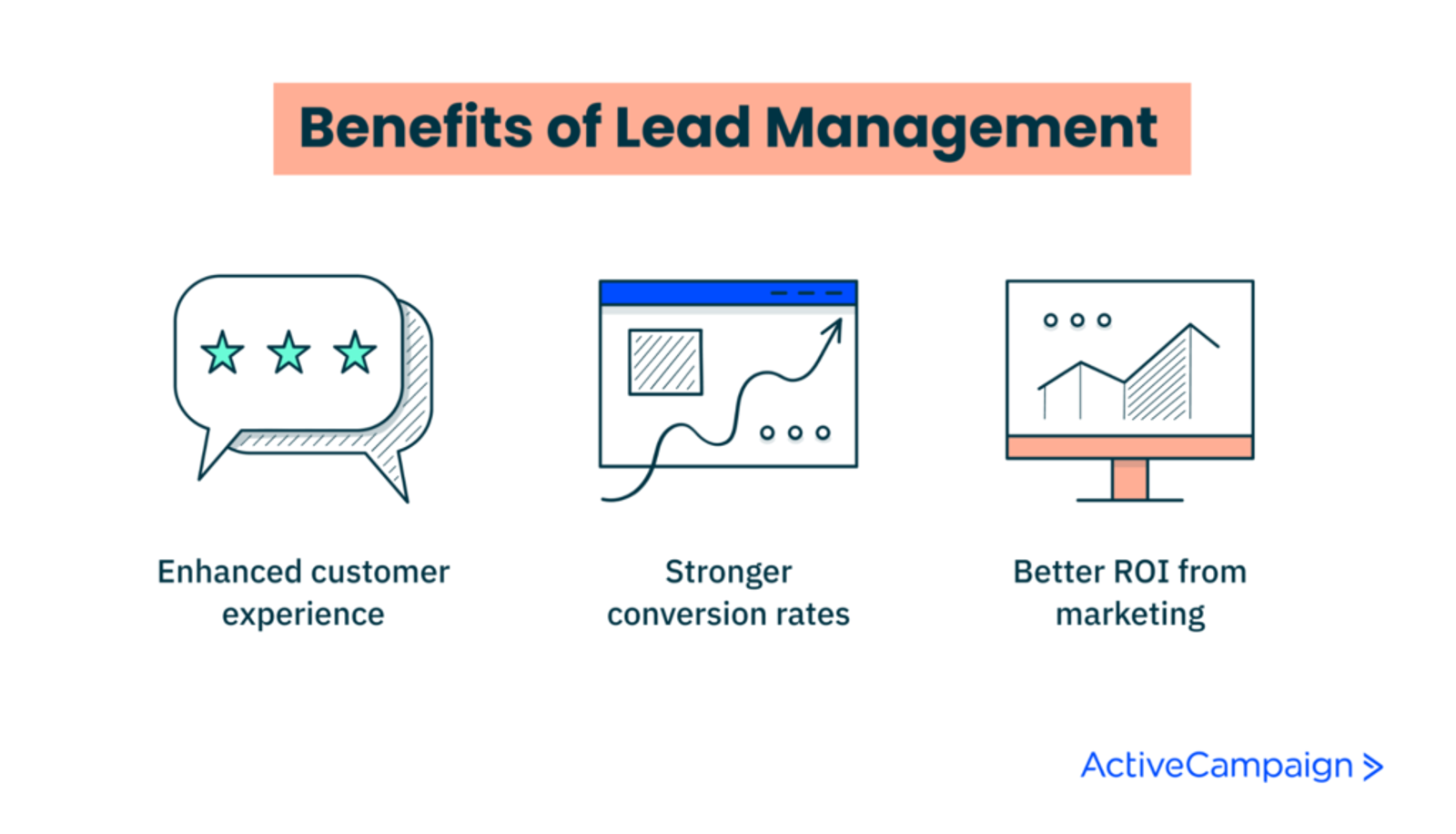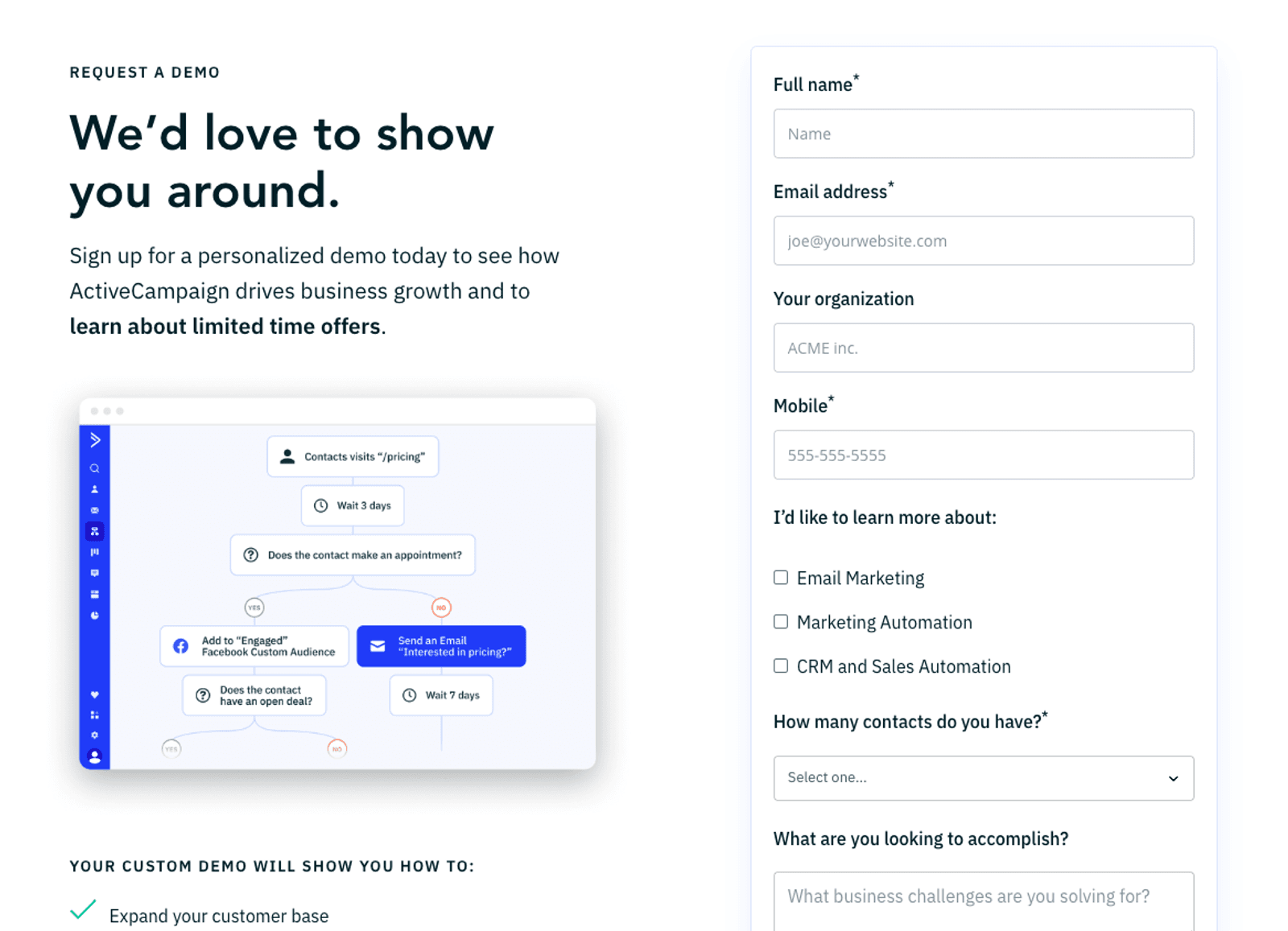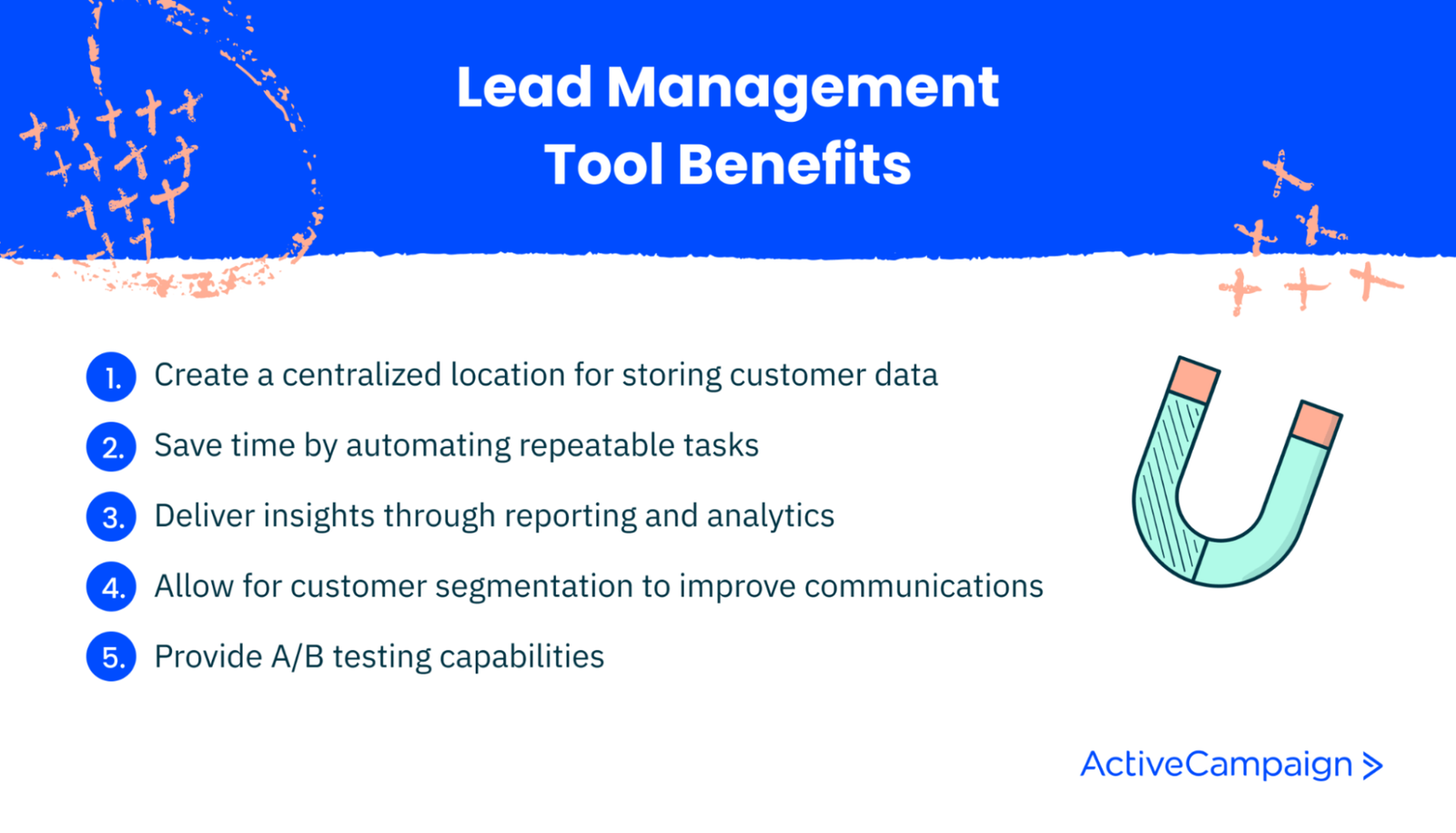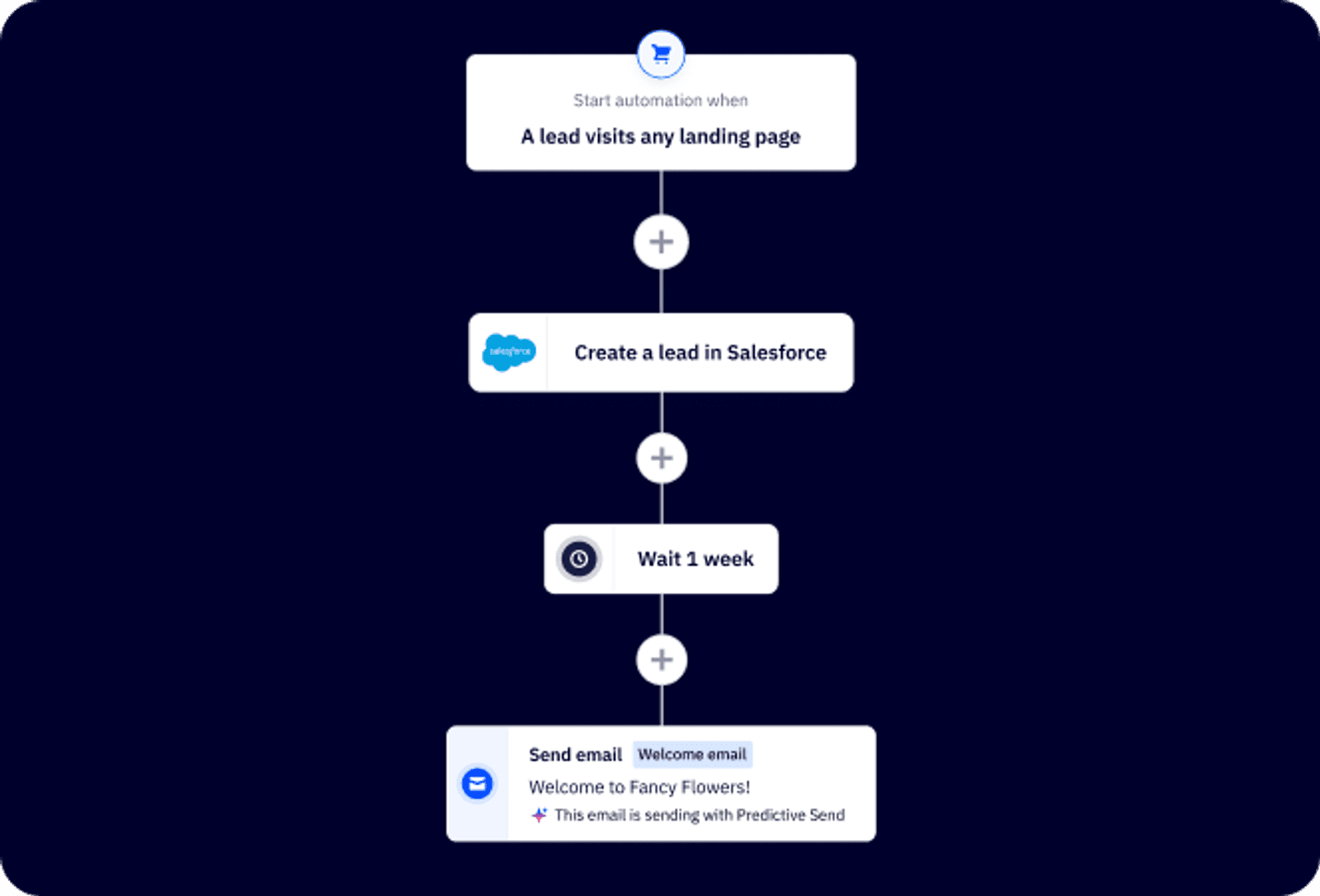Many marketers tend to invest too much time and effort in top-of-funnel activities.
It’s not that these aren’t important—you can’t do a lot if you’re not attracting new customers. The problem is that many of us get so excited at the prospect of capturing more and more leads that we forget that there’s a lot of work to do after we get them to convert.
The solution to this problem is a solid lead management process.
In this guide, you’ll learn how to build that system. We’ll cover the basics of lead management (like the benefits of doing it in the first place and the tools you’ll need) before diving into the eight steps of an effective lead management process.
What is lead management?
Lead management is the process of capturing, storing, monitoring, and tracking leads throughout the customer journey and the corresponding sales process. A better lead management process improves your ability to convert customers and drives a more efficient and seamless customer experience, especially during points of handoff between departments (like when marketing stops and sales takes over).
Let’s look at an example to illustrate this.
Lead management begins when you first capture a lead. At a minimum, this is a customer contact detail (like their email), but it can also include their name, company details (if you’re working in a B2B environment), and some indication of their interest in your product or service.
Leads are generally captured using some form of lead generation devices, like an ebook, webinar, or free account signup. Those leads are stored in your sales CRM, which acts as a lead management system. What happens next depends on your specific processes.
However, leads generally go through a nurturing process where prospects receive a series of emails from your brand. Engagement with these emails and other kinds of content is measured to understand when it’s time for sales to engage. This is known as lead scoring, something we’ll cover later on.
Then, the sales process begins. Leads are tracked throughout the various stages in your sales pipeline until they convert to a paying customer (or you close them as a lost opportunity).
Throughout the lead management process, you’ll track a variety of metrics like:
- Pipeline stage conversion rates
- Engagement with sales content and communication
- Sales cycle length
What are the benefits of lead management?
Managing your leads in a more effective and centralized manner offers several key benefits for sales and marketing teams.

Let’s take a closer look.
Enhanced customer experience
Without a comprehensive lead management system that spans the length of the customer journey, certain aspects of the customer experience can become disjointed. For example, they enter a bunch of data into your lead form, only to be asked the same questions by a sales rep a few weeks later.
Create a holistic customer experience by implementing a lead management system that includes processes to follow and capable lead management software to manage them.
Where ActiveCampaign can help: With ActiveCampaign, you’re able to create a seamless customer journey with automation that keeps teams aligned, personalization that feels human, and innovative tools that make your lead management smarter at every step.
Higher conversion rates
If you’ve got a consistent process for managing leads and improving the customer experience, you’ll bring in more customers. Also important is an effective lead management process with a reporting review step to look back at performance and implement strategies for improvement.
For example, you might see through your pipeline stage conversion rate monitoring that you’re losing a lot of customers at the presentation stage and decide to implement measures to improve your sales team’s ability there.
ActiveCampaign makes this easier by combining automation, personalization, and smart reporting tools—so you’re not just spotting issues, you’re also equipped to fix them faster and more effectively.
Better ROI from marketing
If you’re closing more deals, you’re driving more revenue.
And if you’re doing all of that without increasing your marketing spend (because you’ve implemented a more effective lead management process), you’re not just improving ROI. You’re also making it easier to show the real value of marketing to senior leadership.
That’s where ActiveCampaign shines: By giving you automation, personalization, and innovative tools that help you move leads through the funnel more efficiently and turn more of them into loyal customers.
Best practices for the 8 steps in the lead management process
How lead management tools support the process
Let’s look at a typical 8-step process for managing leads across the customer journey. Bear in mind that these 8 stages should be used simply as a guideline. Every company does something a little different, and you should feel free to adjust the process to taste.

You’ll also probably find that adjustments are required as you put your lead management process into practice and come to understand what works and what doesn’t.
Ready to get started managing your leads? Use these free resources:
1. Capture leads
The first step in the lead management process is where you capture the lead. There are many tactics for this, but the most common is to offer something valuable in exchange for a customer’s contact details.
Examples include:
- Ebooks
- Whitepapers
- Webinars
- Guides
- Free trials
- Discount codes
- Email series
Whatever device you use to capture leads, make sure it’s valuable enough for customers to hand over their emails. A good litmus test is to ask, “Could they get this for free somewhere else online?” If the answer is yes, then you probably need to build more value.
Capture customer details with a lead generation form like this:

Your lead form should be connected to your CRM so the data can go straight into the first pipeline stage.

The full lead gen process is a little outside the scope of today’s lesson. Learn more in our guide below.
2. Score and prioritize leads
Depending on the volume of leads you have coming in daily and the sophistication involved in your lead management system, you might want to implement a lead scoring process.
Lead scoring assigns points to various engagement activities (for instance, whether or not the customer watched a webinar). Then, you set rules as to what defines that lead’s importance or urgency.
For example, you might set a minimum score for sales reps to engage or assign leads to different reps based on priority.

This is often automated.
Your lead management system should allow you to set specific point allocations for different activities, automatically score leads, and assign them based on your lead routing rules. This keeps the whole process hands-off and means that sales reps only need to engage with leads once assigned to them.
If you want to learn more, check out our dedicated guide on lead-scoring best practices below.

Deliver gated content to new contacts and create a deal in your CRM — all with one automation.
3. Enrich leads with additional data
Some companies—particularly those at the enterprise level—choose to integrate data enrichment tools to supplement the information they have on prospects. This helps offset the issue of capturing optimal data in lead forms—the more form fields you add, the lower your response rate tends to be.
Lead data enrichment can also help you obtain helpful qualification information like:
- Annual revenue
- Employee headcount
Most small and medium-sized businesses should be fine without this step in the lead management process. Still, it can be incredibly valuable to implement for those that target enterprise customers.
4. Nurture leads that aren't sales-ready
Some of your company’s leads won’t be ready to speak with a sales rep. SQLs can proceed straight to step five, but as for MQLs, it can be helpful to develop to build out some form of lead nurturing sequence. This tactic aims to provide more useful information to prospective customers and move them further down the sales funnel.
If they’re not ready for sales conversations yet, they’re likely still focusing on top-of-funnel issues. They’re just starting to understand that they have a problem they need to solve. Lead nurture campaigns (which are often email-based but can include a combination of email, SMS, content distribution, and retargeting ads) should guide users down a pathway to purchase.

You’ll start by helping them understand more about the impact of that problem on their daily life. Then, you’ll start discussing potential solutions and the benefits and pitfalls of various options.
This will culminate in recommending your solution over other options and then measuring engagement (using your lead scoring systems) to determine if the lead displays sufficient purchase intent to receive an upgrade to SQL.
Learn more about the lead nurturing process in our guide below.
5. Assign leads to a sales rep
Leads considered sales-ready now need to be routed to a sales rep. There are a few different ways to approach this.

Your lead management platform routes lead to reps are based entirely on your lead routing and assignment rules.
Beyond the round-robin approach, where reps are assigned equally across all reps, there are six common options to consider:
- Lead routing by territory. For instance, West Coast leads go to West Coast reps.
- Lead routing by deal value. Leads with potential values above a certain limit go to more experienced reps and vice versa.
- Lead routing by company hierarchy. For instance, if a given rep already has a relationship with your Fox account, and a lead for a Marvel business comes through (these 2 companies are owned by the same parent company, Disney), it gets assigned to them.
- Lead routing by lead score. High scores are routed to more experienced reps or the nearest available rep, depending on your needs.
- Lead routing by use case. If you serve multiple industries, this lead routing rule can help to ensure that sales reps with the correct expertise serve customers in industries they’re familiar with.
- Lead routing by availability. Leads are routed to the soonest availability rep, maximizing lead response time.
Lead routing can get tricky, especially in large teams with complex territory and company hierarchy rules.
ActiveCampaign helps simplify all of this with automated lead assignment. You can route leads instantly based on score, region, funnel stage, or any combination of custom rules you define. Automated routing in ActiveCampaign can hand off leads to the correct rep the moment they reach your SQL threshold, minimizing delays and potential errors while giving your sales team more time to focus on closing.
Discover how to set up your lead routing processes in our guide below.
6. Engage sales process
Traditionally, this is the part of the lead management process where prospective customers are handed off to the sales team, and the marketing department washes their hands of them. In modern lead management processes, however, the two teams are more collaborative, and marketing tends to support them throughout the entire sales cycle.
How you approach this will depend on your organization, goals, customers, industry, and product, though the general sales process includes these stages:
- Discovery call/qualification/needs assessment
- Product demonstration
- Solution presentation/proposal
- Negotiation and agreement
- Close and contract signing
If there is a clear divide between marketing and sales, specify when and how leads will be handed over. Work together in the same platform (that’s why CRMs are ideal for running lead management processes) to ensure the elimination of data silos.
If you’re working together, describe and communicate exactly who is responsible for what. The last thing you want is marketing and sales bombarding a given lead—or worse, sending opposing messages. Nobody likes mixed signals.
Get your sales process off the ground right now with our free sales process template.
7. Convert leads into customers
The last in the sales process is closing. It’s where your lead finally becomes a customer, and you can count that revenue in your quota this month. This stage should also include a clear handoff process, from sales to customer success.
Customer success’s goal is to help new customers get the most out of your product, maximizing retention and improving their ability to upsell or cross-sell into the account and drive expansion revenue. As such, they’re going to need as much intel on the customer as possible, and the last thing you want is them asking the same questions of a customer that your sales team just asked.
Instead, implement a process where sales reps tidy up any account details and notes in your CRM before handing the lead over to the success team so that nothing is left to assumption.
And with ActiveCampaign, you can take it a step further. When a lead becomes a customer, ActiveCampaign can automatically trigger a personalized onboarding sequence that helps customers get value from day one, while seamlessly notifying your customer success team about key account details. It’s a smoother experience for everyone, right from the start.
8. Track, measure, and improve
No matter how much time you invest in developing a comprehensive lead management process, and no matter how well you follow the advice covered in this guide, you’ll always have room for improvement. In pursuit of this, determine exactly how you’ll track and measure success and how often you’ll look at opportunities to improve.
Some helpful metrics to track here include:
- Deal win rate
- Pipeline stage conversion rates
- Sales cycle length
- Annual recurring revenue growth
- Average deal size
- Return on marketing and sales investment
Set up a custom reporting dashboard in your CRM to track the metrics you want access to in real time.

Additionally, establish a cadence for reviewing performance and assessing opportunities to improve. Monthly or quarterly should suffice, depending on the size of your company and the agility you can actually implement changes.
How lead management tools support the process
To manage leads effectively, you’re going to need a software platform.
Yes, you can technically do this in a spreadsheet, but that approach will be largely ineffective for anyone with more than a handful of leads to process. Instead, you should look to incorporate a lead management software platform into your process.

These software platforms improve the lead management process because they:
- Create a centralized location for storing customer data
- Save time by automating repeatable tasks
- Deliver insights through reporting and analytics
- Allow for customer segmentation to improve communications
- Provide A/B testing capabilities
ActiveCampaign’s CRM takes the busywork out of lead management by giving you one place to store, segment, and act on all your customer data. You can easily automate follow-ups based on behavior or lead score, segment contacts by engagement or deal stage, and track everything with clear, customizable reporting. It’s built to be easy to use, so you spend less time wrangling tools and more time actually moving leads forward.
Of course, it’s important to understand how the lead management process works before introducing a new lead management software into your company.
How to evaluate and select the right lead management software
Finding the right lead management software isn’t just about picking a tool with the most features—it’s about choosing the one that actually fits your team, your workflows, and where your business is headed. The right system should make your day-to-day easier, not more complicated.
There are a few key things to keep in mind as you evaluate your options.
Accelerate team onboarding with an intuitive interface
No one wants to spend weeks learning a new tool, especially when leads are coming in fast. A clean, user-friendly interface helps your team get up to speed quickly so you can start seeing value without dragging down productivity. The more intuitive the system, the less you’ll need to lean on training sessions or documentation. That means less downtime and faster adoption across sales and marketing teams.
Prioritize integration options for greater workflow efficiency
Your lead management tool should play nicely with the tools you already use. Whether it’s your CRM, email marketing platform, or social media scheduler, smooth integration means fewer manual steps and less jumping between systems. When data flows freely between platforms, your team can spend more time building relationships and less time copy-pasting info from one tool to another.
Go all-in on automation to boost productivity
The real magic of modern lead management software lies in automation. You shouldn’t have to assign leads manually, remind your reps to follow up, or keep tabs on every single lead status update.

With automation in place, tasks like lead scoring, follow-up emails, and rep assignments can happen instantly and accurately, freeing up your team to focus on closing deals and building connections.
Choose with the future in mind
What works for you now might not work a year from now. That’s why it’s worth investing in a solution that’s built to grow with you. Look for customization options that let you tailor workflows to your unique sales process, and check that the platform can scale—adding new users, handling more data, and adapting as your strategy evolves. Flexibility now saves major headaches later.
Protect your business and customers with strong security and compliance features
Don’t let security be an afterthought. Your lead management software will be handling a lot of sensitive customer data, so it’s critical that it meets industry-standard security protocols and complies with data protection regulations like GDPR or CCPA. Look for encryption, role-based access controls, audit logs, and regular updates (things that give both you and your customers peace of mind).
Elevate your sales strategy with ActiveCampaign’s lead management solutions
Implementing a lead management process is key to making your sales and marketing efforts more effective and creating a smoother experience for your customers from first touch to long-term loyalty. But even the best process needs the right tools behind it.
With ActiveCampaign’s powerful automation and personalization features built right into the platform, you have the power to manage leads more efficiently and move them through the funnel with less manual work.
Ready to see it in action? Sign up for a free trial today.
Lead management FAQs
Lingering questions? We’ve got you.
What are some free or low-cost lead management solutions?
There are several budget-friendly lead management tools available. Options like HubSpot’s free CRM, Zoho CRM, and ActiveCampaign (which offers a free trial) provide small teams with an accessible way to manage leads. However, it’s important to review what’s included, as some free plans may limit features like automation or reporting.
Is lead management part of CRM?
Yes, lead management is a fundamental component of most CRM systems. It enables businesses to organize, track, and engage with leads throughout the sales funnel, helping streamline workflows and improve follow-through.
What automations can reduce manual tasks for small teams handling lead management internally?
Automations such as lead scoring, automated follow-ups, and rule-based lead assignments can significantly reduce manual workload. ActiveCampaign offers a library of automation recipes that allow teams to implement these processes quickly, saving time and improving efficiency without the need for complex setup.








